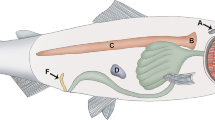Abstract
The gastrointestinal tract develops from a simple tube to a complex organ with patterns of differentiation along four axes of asymmetry. The organ is composed of all three germ layers signaling to each other during development to form the adult structure. The gut epithelium is a constitutively developing tissue, constantly differentiating from a stem cell in a progenitor pool throughout the life of the organism. Signals from the adjacent mesoderm and between epithelial cells are required for normal orderly development/differentiation, homeostasis, and apoptosis. Embryonically important patterning factors are used during adult stages for these processes. Such critical pathways as the hedgehog, bone morphogenetic protein, Notch, Sox, and Wnt systems are used both in embryologic and adult times of gut development. We focus on and review the roles of these factors in gut epithelial cell development and differentiation.
Similar content being viewed by others
Author information
Authors and Affiliations
Corresponding author
Additional information
Received 18 October 2002; received after revision 18 December 2002; accepted 18 December 2002
Rights and permissions
About this article
Cite this article
de Santa Barbara, P., van den Brink, G.R. & Roberts, D.J. Development and differentiation of the intestinal epithelium. CMLS, Cell. Mol. Life Sci. 60, 1322–1332 (2003). https://doi.org/10.1007/s00018-003-2289-3
Issue Date:
DOI: https://doi.org/10.1007/s00018-003-2289-3




